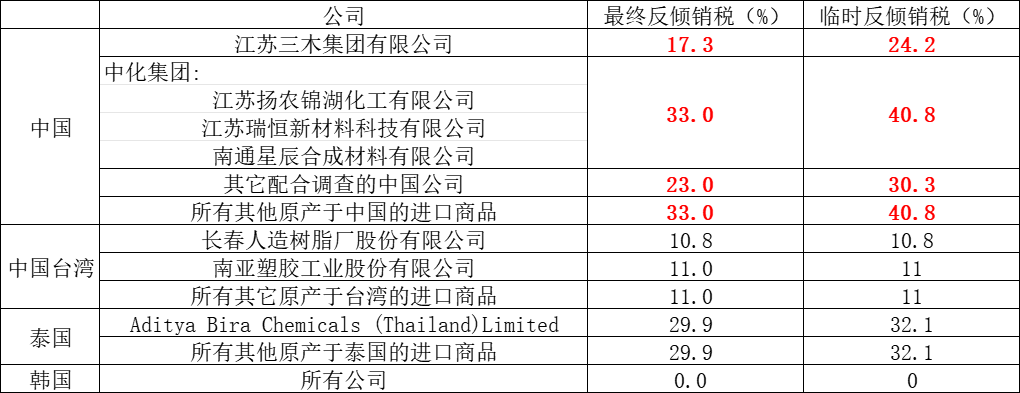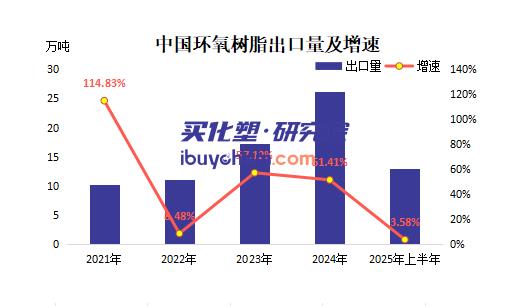From 24.2% to 17.3% EU Anti-Dumping Final Ruling Loosens But China Epoxy Resin Exports Still Under Pressure
On July 28, 2025, the European Commission officially announced the final anti-dumping ruling on epoxy resin from mainland China, Taiwan region of China, and Thailand, marking the end of a trade dispute that had lasted for more than a year. Although the EU ultimately maintained the imposition of anti-dumping duties, Chinese companies, through active responses to the investigation, succeeded in securing a final duty rate significantly lower than the provisional rate.
According to the final determination, the EU's final ruling presents three major changes.
Corporate tax rates in China are generally being reduced.Jiangsu The group's provisional tariff was reduced from 24.2% to a final tariff of 17.3%; companies under Sinochem Group saw their rate drop from 40.8% to 33.0%; other cooperating companies had their rate reduced from 30.3% to 23.0%; and the rate for all other Chinese exporters was lowered from 40.8% to 33.0%. This adjustment has directly reduced the export cost pressures on enterprises.
Differentiated adjudicationThe EU imposes differentiated tax rates on companies that cooperate with investigations (23.0%) and those that do not (33.0%), highlighting the substantive value of responding to investigations.
South Korea ExemptionThe EU has terminated its anti-dumping investigation into epoxy resin from South Korea, determining that there was no dumping or that it did not cause material injury to the EU industry.
The EU's final anti-dumping ruling "eases restrictions"
The anti-dumping investigation began on July 1, 2024, during which the EU imposed provisional anti-dumping duties on epoxy resin exports from mainland China, Taiwan, and Thailand.MaihuaSuAccording to the research institute's monitoring, the average monthly export volume of epoxy resin from China to Europe in 2024 was about 25,000 tons. However, since the temporary tariff was imposed in February 2025, the export volume has declined month by month, dropping to 20,800 tons in June, a decrease of 23.5%.
The investigated enterprises mainly include Jiangsu Sanmu and Sinochem Group from mainland China, Nan Ya Plastics from Taiwan, and Aditya Birla from Thailand. Among them, the mainland Chinese enterprises actively defended themselves by submitting complete cost data and justifying the reasonableness of their pricing, ultimately achieving a reduction in the tax rate.
The New Landscape under Capacity Expansion and Demand Differentiation
As of the first half of 2025, the growth rate of epoxy resin supply in China has exceeded the growth rate of demand, with capacity expansion continuing. China's epoxy resin capacity has reached 3.56 million tons, an increase of 3.18% compared to the end of 2024. However, downstream demand varies significantly, with the wind power industry showing strong demand. Essential restocking has driven prices up, while demand in coatings, electronics, and other downstream sectors remains subdued. The European Union and the United States have initiated anti-dumping and countervailing investigations against Chinese epoxy resin, affecting some export orders, leading to a decrease in exports to the U.S. and the EU. In the first half of 2025, the main export trading partners for epoxy resin also changed, with exports to the Middle East increasing.
Although the reduction in tariff rates has alleviated some pressure, the remaining tariffs of 17.3%-33.0% will still significantly undermine the price competitiveness of Chinese epoxy resin in the European market. In the short term, exporting companies may face two options: shifting to emerging markets, with regions such as the Middle East and Southeast Asia potentially becoming alternative export destinations; or some companies may bypass trade barriers by establishing overseas factories, as exemplified by Sinochem Group's epoxy resin project in Saudi Arabia.
The EU's ruling this time is not an isolated incident. In recent years, Europe and the United States have frequently launched anti-dumping investigations into Chinese chemical products, such as the United States on polyvinyl chloride (PVC).PVCHigh tariffs are imposed on titanium dioxide and other products. This trend indicates that with the restructuring of global industrial chains, trade protectionism is becoming the norm.
【Copyright and Disclaimer】The above information is collected and organized by PlastMatch. The copyright belongs to the original author. This article is reprinted for the purpose of providing more information, and it does not imply that PlastMatch endorses the views expressed in the article or guarantees its accuracy. If there are any errors in the source attribution or if your legitimate rights have been infringed, please contact us, and we will promptly correct or remove the content. If other media, websites, or individuals use the aforementioned content, they must clearly indicate the original source and origin of the work and assume legal responsibility on their own.
Most Popular
-

List Released! Mexico Announces 50% Tariff On 1,371 China Product Categories
-

EU Changes ELV Regulation Again: Recycled Plastic Content Dispute and Exclusion of Bio-Based Plastics
-

Clariant Unveils Cost-Cutting Plan Details, Plans to Shut Down Multiple Plants
-

Mexico officially imposes tariffs on 1,400 chinese products, with rates up to 50%
-

Nissan Cuts Production of New Leaf EV in Half Due to Battery Shortage








